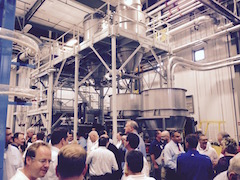June 30, 2015
Kansas State University Bulk Solids Innovation Center celebrates open house

The weather was wheat-harvest warm on June 24 as a new K-State research facility hosted an open house attended by representatives from more than 60 companies. Attendees came from as far away as Switzerland and as close as across the street to hear how the Kansas State University Bulk Solids Innovation Center in Salina can help them better understand how to handle loose, dry commodities and powders, including the wheat locals were cutting in nearby fields.
Matt Burt, K-State graduate and general sales manager at Coperion K-Tron in Salina, an anchor tenant of the center, said he and his staff are excited about the facility.
"It's a great lab with academia associated with K-State, right here in our own backyard," he said. "It's one of a kind in the United States, and it's a great showcase of our equipment and all the technology and capabilities from vacuum sequencing to continuous pressure and vacuum to dense-phase conveying of bulk solids."
Todd Smith, K-State graduate and general manager of Coperion K-Tron, served as master of ceremonies. Smith welcomed other speakers, including K-State Vice President for Research Karen Burg, K-State Salina CEO and Dean Verna Fitzsimmons, Salina Chamber of Commerce CEO Frank Hampton, and Vortex owner Lee Young. Vortex is a Salina-based company that makes valves for handling dry bulk solids. All mentioned the special nature of the collaboration among industry, local agencies, and academia that led to the building of the center.
Burg said she was happy to see the center open for business and welcomed industry collaboration. She emphasized that the center will facilitate both research and education by providing an opportunity for hands-on learning. Students learn more of what they need to know in a real-world environment, and employers benefit, too, because they don't have to spend as long training new hires.
"I know in my classroom-based education as an engineer, everything was centered around textbook equations, and it wasn't until I had an internship that it all came together and seemed real," she said.
The event also highlighted the history of bulk solids handling in the area. Salina was one of the largest flour milling centers in the country in 1942, when flour was packed by hand into bags 24 hours a day, 7 days a week. John Landes, the head miller from the flour supplier, searched for a better, more efficient way to move flour and in 1953 devised transport in a specially lined boxcar unloaded with a screw auger. In 1954, Landes began testing a pneumatic conveying system, and he worked with Salina Manufacturing Co. to build the necessary equipment in 1955. Improvements led to the first flour mill without hand-packers in 1958.
Local companies soon began to investigate conveying materials other than flour and fostered further innovations, making Salina a fitting location for the Bulk Solids Innovation Center.
Kurt Sundgren, a 2003 K-State milling science graduate, is a process engineer at SAFC in Lenexa. His company makes cell culture media powder used by biopharmaceutical manufacturers, and he knows the challenges of handling bulk solids well.
"We make batches of powder with varying recipes, so understanding the powder properties is incredibly important for us," he said. "The bulk solids lab will help us with that, because they have the ability to use the same kind of equipment we would use in the field and do the testing we would perform to utilize the powder."
Sundgren echoed Burg's comments about hands-on learning and noted that he's eager to use the center as a recruiting tool.
"There's a gap between what people are learning in school and what you need to know in the field for bulk solids handling," he said. "There's nothing I can think of locally that offers this level of expertise and ability to play with the powder in a research format. That's a big deal."
Sundgren added that bulk solids handling is difficult to teach in a classroom setting. "It's non-Newtonian physics, so it's a tricky thing. There's not a lot of classes where they just teach you this," he said.
"I'm looking for candidates for future employment. The center is close by, and I can pull from K-State personnel for internships and employment. I'm excited about that," Sundgren said.
